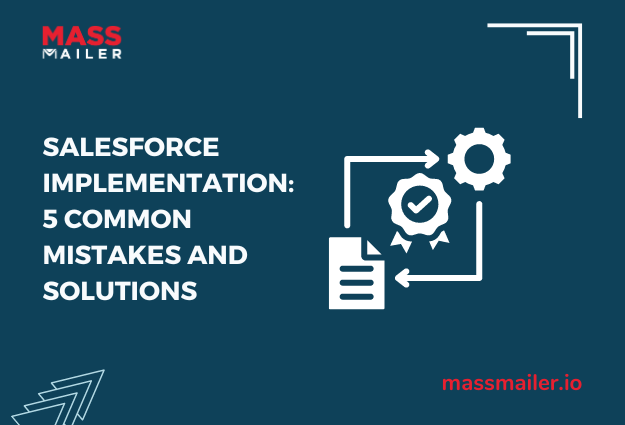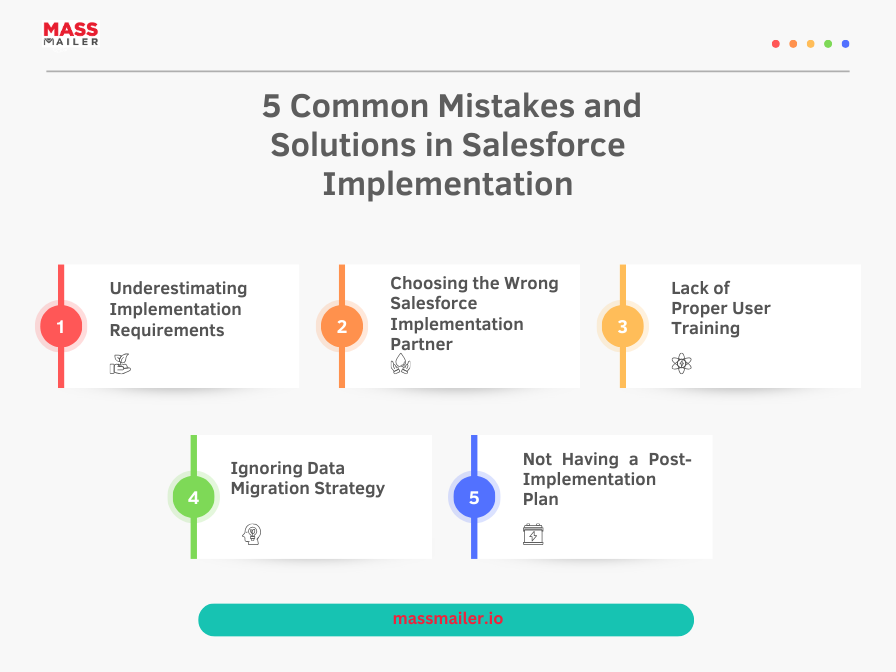Salesforce Implementation: 5 Common Mistakes and Solutions
Salesforce is a game-changer for customer relationship management (CRM). It has over 150,000 customers, and 88% of Fortune 100 companies use Salesforce. It streamlines your sales process, centralizes customer data, and empowers you to build stronger relationships. But to truly unlock its potential, a smooth implementation is crucial.

Many companies struggle when it comes to Salesforce implementation, and this is despite the tool offering a simple implementation process. Organizations often rush the process, overlooking crucial details and neglecting proper user training, leading to multiple issues.
Want to avoid these common pitfalls? In this blog, we’ll unveil 5 common Salesforce implementation mistakes and provide solutions to help you navigate the process flawlessly. By avoiding these pitfalls, you’ll be well on your way to maximizing the value of your Salesforce investment and implementing Salesforce the right way. Let’s dive in!
5 Common Salesforce Implementation Mistakes & Solutions
If you are implementing Salesforce cloud for your organization, here are a few common mistakes that even seasoned Salesforce professionals end up making:
Mistake #1: Underestimating Implementation Requirements
We all want to see results fast, which can sometimes lead to cutting corners during the Salesforce implementation. But rushing through this critical phase can have severe consequences down the road. A common mistake is underestimating the complexity of the process.
Migrating your existing customer data to Salesforce, for instance, might seem straightforward. However, the migration process can become a time-consuming nightmare if your data is messy or riddled with inconsistencies. Customizing Salesforce to perfectly align with your unique workflows and business processes requires careful planning and attention to detail.
A thorough needs analysis is paramount to avoid these pitfalls. This involves defining your specific goals for using Salesforce and identifying the resources you have available. Plus, you must safeguard your data if something goes wrong during the implementation. To do this, follow our guide to understand why Salesforce backups must be indep to protect your data.

Mistake #2: Choosing the Wrong Salesforce Implementation Partner
Imagine building your dream house and realizing halfway through that the contractor doesn’t quite understand your vision. Choosing the wrong Salesforce implementation partner can lead to a similar scenario. An inexperienced or incompatible consultant can create a system that doesn’t meet your needs or integrate poorly with your existing infrastructure.
The right partner, however, becomes an extension of your team. They bring a wealth of Salesforce knowledge and experience to the table, ensuring a smooth and successful implementation.
So, how do you find the perfect match? When selecting a consultant, consider factors like their experience with Salesforce implementations in your industry. Do they have a proven track record of success with similar-sized companies and business models? Or can they back up their promises with references and certifications?
The right partner will help you throughout the process and save you time and resources needed for Salesforce implementation.
Mistake #3: Lack of Proper User Training
Salesforce is a powerful tool, but even the most sophisticated software can’t work its magic without proper user training. Imagine handing your team a Ferrari and expecting them to win a Formula One race without any driving lessons.
That’s essentially what happens when you implement Salesforce without equipping your team with the knowledge and skills to use it effectively.
A poorly trained team will struggle to navigate the system, leading to frustration, low adoption rates, and, ultimately, a hindered return on investment (ROI). They might miss out on key features or revert to old, inefficient ways of working.
The key to success is a multi-layered training approach. Start with comprehensive initial training sessions that cover the fundamentals of Salesforce and how it aligns with your specific roles. This includes hands-on exercises and real-world scenarios to help you solidify your understanding and know how to rectify any issues that you may encounter.
You may even follow our Salesforce training guide for a holistic implementation.
Mistake #4: Ignoring Data Migration Strategy
Salesforce is only as good as the data it houses. Dirty, inaccurate, or incomplete data can frustrate users and ultimately hinder CRM efforts. Many companies underestimate the importance of data quality during migration. This can lead to a scenario where duplicate records clog the system, hindering performance and creating confusion.
Additionally, inconsistent data formats or missing information can make it difficult to generate accurate reports and gain valuable insights from your customer data.
A sound data migration strategy ensures your Salesforce implementation starts with a clean and reliable data foundation. This might involve deduplication efforts, correcting inconsistencies, and enriching existing data with additional details. Consider utilizing data migration tools or partnering with data cleansing specialists to ensure a smooth and efficient migration process.
To help you migrate your data and manage any errors, you can follow the steps to manage your contacts in Salesforce for a smoother transition.
Mistake #5: Not Having a Post-Implementation Plan
The celebration after a successful Salesforce implementation can be short-lived if you fall into the trap of thinking it’s a “set-and-forget” solution. Just like any complex system, Salesforce requires ongoing maintenance and user support to ensure it continues to deliver value.
Neglecting post-implementation efforts can lead to several issues. Without regular monitoring, user adoption rates might decline as initial excitement fades. Additionally, data quality can deteriorate over time if new information isn’t entered consistently or existing data isn’t updated regularly.
To avoid these issues, make sure you have a proactive post-implementation plan. This plan should include processes for monitoring user adoption, data quality, and system performance. Regular reports and analytics will help you identify areas for improvement and ensure your Salesforce instance continues to meet your evolving business needs.
Here is the ultimate guide to Salesforce for marketers, which will help you with not only implementation but also powerful post-implementation strategies.
Conclusion
Salesforce has the power to transform your business, but these common pitfalls can derail your entire Salesforce implementation and create unsatisfactory experiences. Although Salesforce is a powerful tool for end-to-end business communication, its true potential lies in a well-planned implementation.
By prioritizing a thorough needs analysis, selecting the right partner, investing in user training, and implementing a sound data migration strategy, you can navigate the process with confidence. Ready to harness Salesforce’s full marketing power? Sign up for a free MassMailer trial today and discover how our seamless integration can transform your email marketing efforts.
You can control your campaigns, personalize interactions, and unlock valuable customer insights within the familiar Salesforce CRM environment.
About MassMailer
Mass Mailer is a powerful email marketing provider designed specifically for Salesforce users. It seamlessly integrates with your existing Salesforce CRM, allowing you to leverage the wealth of customer data you’ve already collected. This translates to highly targeted and personalized email campaigns that resonate with your audience and drive real results.
Sign up for a 15-day free trial to understand how MassMailer simplifies the entire email marketing process and empowers you to achieve your marketing goals.
